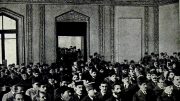The 11th Red Army invasion of Azerbaijan on April 27, 1920, brought an end to the existence of the First Republic (ADR). A number of domestic and foreign factors contributed to the implementation of this act of invasion, placing the Azerbaijani government in a vulnerable position, which greatly eased the task of capturing the oil-rich areas of Baku by Soviet troops (1). If the initial plan of the soviet leadership was to take control of the Baku province, which is reflected in a directive of the Caucasus Front Command dated April 21, but then a bit later, on April 23, the change was made in this directive, making the ultimate goal of the 11th Army not only the occupation of the territory of the Baku province, but also the whole Azerbaijan (2). In fulfillment of appropriate orders, the Red Army, towards the end of May, already controlled most of the current territory of the Republic of Azerbaijan.
In parallel, the Bolsheviks began to implement measures to strengthen their political authority on the ground. To do this, first of all, the Soviet units were tasked to neutralize people capable of resisting to the Soviet power. To this end, on April 21, a telegram sent to the commander of the 11th Army contained a specific order to “at all costs capture the current Azerbaijani government. In anticipation of their escape to Elisabethpol, it is necessary to intercept them before the Kurdamir railway station” (3). Thus, one of the principles of an ultimatum adopted by the Parliament of Azerbaijan, which guaranteed “the sanctity of life and property of members of the government and parliament” (4), was just an empty promise. In fact, former members of the Azerbaijani government and the parliament have been subjected to persecution and systematic physical destruction (mainly those who did not recognize the Soviet regime). The first victim of this kind was the former Prime Minister of Azerbaijan N. Usubbeyov. He was caught by the Bolshevik detectives in the Kurdamir district and brutally killed in Guruchay gorge (5). Those who have managed to somehow avoid persecution started arriving in Tbilisi. This choice was no accident; the city had a favorable geographical location. From here it was easy to establish and maintain contact with Ganja, the second city of Azerbaijan after Baku, which, compared with more cosmopolitan at that time Baku, was the traditional hub of the Azerbaijani national movement. Foreign missions of the Entente states were in Tbilisi, which gave the leaders of the Azerbaijani rebels an opportunity to keep the heads of diplomatic missions of Britain, France, Italy and the US apprised of any developments taking place in the territories occupied by Russians (6). N.K. Sheykhzamanli (one of the founders and head of the Azerbaijani secret service) wrote in his memoirs about the plans to resist the enemy in Ganja:” Before the invasion of Russian troops, the Cabinet of Ministers decided to move the capital back to Ganja and from there lead the struggle against the Red Army” (7).
Part of the political elite not being able to accept the fact of occupation of Azerbaijan by Soviet troops was not the only reason for the beginning of the anti-Bolshevik resistance, which resulted in a major uprising in Ganja. Social tensions, raised by arbitrariness of the commanders of the Red Army, despite a direct order “not to hurt the local population in any way” (8), became criminal in nature. This situation was described (already after the suppression of the uprising) by the former Prime Minister and Foreign Minister of Azerbaijan Fatali Khan Khoyski, “during the first 6 days of the Bolsheviks entering Azerbaijan, the situation in Baku remained calm. It changed as soon as the member of the Caucasian Bureau of the Central Committee of the RCP (b) G. Ordzhonikidze and the commander of the 11th occupying army M. Lewandowski arrived in Baku. The Bolsheviks began disbanding of Azerbaijani Army, units of which were either dismissed or absorbed into the 11th Army… Until the end of May, Baku was looted to the ground. Supplies and manufactured goods, which were in abundance in the capital of Azerbaijan before the invasion of the Bolsheviks, gradually disappeared, being massively exported to Central Russia. The result was that by the end of May the city has been experiencing a chronic shortage of bread. All this has caused widespread discontent in society, including among the members of the Gummet and Ittihad parties, which contributed to the invasion of Azerbaijan by the Bolsheviks. Bolshevik newspapers have regularly published lists of “counter-revolutionaries”, being executed en masse. These were the main causes of the Ganja revolt” (9). Appointed chairman of the Council of National Economy N. Solovyev wrote in his report, “Our policy in Azerbaijan within three months after the coup”, to Lenin: “The new government (Revolutionary Committee) consisted entirely of Muslims. That was good, but it was no secret that the Revolutionary Committee is under the oversight of the Central Committee of Azerbaijan Communist Party, where the leading role belongs to the Georgian-Armenian group… The intelligentsia and the bourgeoisie that were arrested and executed were almost entirely Muslim…” (10).
After the occupation, the situation in Ganja continued to deteriorate. Just days before the start of the uprising on May 12, the former governor of Ganja Hudadat Bey Rafibeyli was taken out of town and shot in Baku on May 20 (11). It should be noted that there was a thorough preparation for the uprising. Caches of weapons and armed groups of residents of the surrounding villages were arranged in advance. The uprising plan was prepared by a group of officers led by the chief of the Ganja garrison Major-General Javad bey Shikhlinski and the commander of the Ganja infantry regiment Jahangir bey Kazimbeyov. The construction of fortifications was entrusted to Major-General Mammad Mirza Qajar. Commander of a cavalry division, General Teymur bey Novruzov, participated in the preparation for an uprising (12). The memoirs of one of the immediate participants of the events J. Kazimbeyov have valuable information about the course of the uprising. According to them, the leaders of the uprising were planning to use the element of surprise, quickly disarm the Red Army in Ganja and together with units of the Azerbaijani army located in Karabakh join Georgian forces and liberate the country. For this purpose, “on May 16, two Georgian officers (colonels A. and E.) were sent to Tbilisi, secretly staying in Ganja. Officers have been introduced to the attack plan and given the task to establish contact with the Georgian army (it was during the Georgian army fighting with the Red Army at the Poylin Bridge). To establish the connection with the main forces of the Azerbaijani Army, located at that time in Karabakh, other 2 officers were sent, provided with appropriate instructions and introduced to the action plan” (13). On May 22, influential public and political figures of the city were gathered, who enthusiastically expressed consent for the uprising and promised to take all measures so that the Azerbaijani population fully supports its regiment” (14). On that day, it was agreed that the guerrilla groups led by Gachag Gambar, Sari Alekper and others will assist national army units in taking over the important objects of the city and its Armenian part (15). At the time of the uprising, the forces of the Azerbaijani army consisted of the 3rd Infantry Regiment of Ganja, Sheki 3rd Cavalry Regiment, one artillery battery and the command headquarters with total number reaching 1800 people. Soviet units stationed in Ganja controlled the 178th and 180th infantry regiments of the 20th Division (located in the Armenian part of the city), communications battalion and commandant part of staff of the 3rd Brigade in the north-western part of the city (populated by Azerbaijanis). With a total of 2000 soldiers and 30 machine guns and one artillery battalion, the Bolsheviks could also count on the help of the 20th Cavalry Brigade (450 horsemen in the village of Zurnabad), an artillery battery with eight machine guns and divisional artillery headquarters in the village of Elenendorf, 6 km from Ganja, with two batteries, each armed with two guns. The 3rd Brigade of the Bolsheviks was commanded by a former officer of the tsarist army Schirmacher (16).
According to the plan of the uprising, on May 22, “at 8 pm, battalions, after arresting political commissars of the regiment sent by the red command, begin to carry out their task… By 11 o’clock it was all over: Russian division and “Sharia Regiment” were disarmed and imprisoned in the city jail. During the night of 22 to 23 May, Ganja was in the hands of the patriots that rose up against the foreign violence” (17). The uprising began on the night of 25 to 26 May. Despite the fact that, after fierce street fighting with the 178th and 180th regiments, the rebels were forced to retreat to the Azerbaijani part of the city, they managed to capture 3 batteries – one mountain and two light ones. By the end of the day, May 26, managed to capture the railway station. However, on May 27, using an armored train brought from Kazakh, the commander of the 20th Division Velikanov managed to retake the station. In parallel, the same day the rebels were able to repel the seven attacks of the Soviet troops that were trying to storm the city (18). The next day, May 28, the 18th Cavalry Division under the command of P. Kuryshko, howitzer battalion and four armored trains were diverted to Ganja (19). The battle, which began at 11 am and was conducted under Kazimbeyov’s personal command, is described in his memoirs as follows: “A wall of gunfire from five guns with buckshot, 22 machine guns and almost 2 battalions of infantry with the guerrillas, creates enormous devastation in the ranks of the attacking enemy. The entire field in front of the Azerbaijani positions is covered by dead bodies of men and corpses of horses, and many injured. Only single riders manage to escape the deadly fire. As it was established later, the attack of the cavalry division was liquidated” (20).
Despite the successful resistance to the enemy, during the night of 28 to 29 May the rebels have received the news of the peace treaty between Soviet Russia and Georgia. A treaty concluded back in May 7, 1920, made it impossible for Azerbaijan to receive military assistance from Georgia. The Commander-in-Chief of the Georgian armed forces, General Giorgi Kvinitadze, who planned to launch an offensive to oust the Bolsheviks from the entire Caucasus, on May 18, unexpectedly received an order to cease hostilities and withdraw troops to their original positions, despite his desperate attempts to convince the Georgian Prime Minister N. Zhordania in the opposite (21).
On May 29, Soviet units made a new attempt to capture the city. Shortly before the start of the offensive, Kuryshko’s 18th cavalry division, after bloody battles, managed to take control of the road leading to Hachbulag near Balchyly. Thus, the area between Ganjachay and the village of Balchyly came under control of the forces of the 18th Cavalry Division. At the appointed time, the Bolsheviks began an offensive on all fronts. Long after midday, the 178th and 179th Infantry Regiments managed to enter the city, and began bloody street battles. Soon, however, they were attacked from the flanks and, unable to withstand strong pressure, retreated to their original positions. The rebels did not let the Red units that were attacking from the Armenian part of the city to the shores of Ganjachay. Kuryshko’s cavalry that tried to break into the city from the south and southwest also have not coped with the task (22).
Before the final offensive on Ganja, the Bolsheviks hastily transferred additional forces from the Georgian border (2nd Brigade as part of the 175th and 176th regiments and one light artillery battalion commanded by Wojciechowski). They also gathered five infantry and six cavalry regiments, 7 special units, 2 armored divisions, 8 armored trains, 57 heavy guns and Armenian units, not counting allegedly uncontrolled Armenian armed gangs, totalling 3000 men. On the morning of May 31, the Bolsheviks began their offensive with heavy artillery support. The turning point in the day was the release of the captured Red Army men and commanders with the help of extraordinary commissioner of Azerbaijan Communist Party G. Sultanov and S.M. Afandiyev who arrived from Baku. Exactly these troops, suddenly appearing behind the defenders of the city, turned the tides. Armed at the nearby arms depots, they organized street battles right in the center of Ganja (23).
Realizing the pointlessness of further resistance, the leaders of the uprising have suggested the evacuation of the city population (knowing the cruelty and ruthlessness of the enemy, it was said that everyone can leave the city under the cover of troops).The evacuation was scheduled for June 2nd. According to Qazibeyov’s memoirs: “This plan was fully implemented… A continuous stream of residents poured into the formed breakthrough, leaving the city and heading to the village, located in the mountains…” (24). Nevertheless, we must admit that there have been noticeable losses among the insurgent population and Soviet troops. Chairman of the Central Bureau of Turkish Communist organizations Mustafa Suphi, in his report “on the visit to Ganja”, stated: “The Red Army intruders acted quite tough… There are between 3500-4000 killed civilians (women and children, wounded are not found). All the bodies were found mostly in the gardens, in homes and basements. … The behavior of our units can be easily explained by the fact that in front of them, not only the askers (soldiers) but also the population, even the women, took an active part in the uprising. In front of their eyes, dozens of fellow comrades were killed and wounded. Besides, the provocations of Armenian informants instigated them. … From our side, there are up to 1,500 killed and wounded Red Army soldiers. In order to preserve the population, up to 12 000 people have been arrested by our command, kept in prisons and in basements” (25). In its secret report on Ganja events, the French mission in the Caucasus reported that “All the Muslim part of the city is destroyed, among the dead there are children aged 2-3. Among women subjected to sexual abuse, we found an 8-year-old girl” (26).
The Ganja events (that inspired a series of uprisings in other regions of Azerbaijan) not only showed the essence of the new government, but also showed that in Azerbaijan there were people ready to fight for the preservation of the political independence of their homeland. Azerbaijanis have shown that they can fight looking death in the eye. It is not surprising that immediately after the uprising, a process was launched for destruction of the military elite of Azerbaijan (that very force that pushed and led the people to the resistance). In just one night, on Nargin Island, together with the officers involved in the uprising, 70 servicemen of the Azerbaijani Army were executed. In total, during 1920, 500 Azerbaijani soldiers were killed, among which there are the names of the prominent ADR military commanders, such as H. Salimov, M. Sulkiewicz, H. Gaytabashi and others (27).
Used sources:
- See: M. Farid “The April 1920 invasion, the fall of the first republic” (12.2016)
- Russian Revolution and Azerbaijan: Difficult Road to Independence, 1917-1920: monograph/ J. Hasanli – Moscow: Flinta, 2011 (p. 594)
- Tukhachevsky, S. Ordzhonikidze and Zakharov – the commander of the 11th Army 21.04.19- 20// Russian State Archive of Socio-Political History. f. 85, op. 8, d. 1, l. 79.
- Azerbaijan Democratic Republic (1918-1920). Parliament. Verbatim records. V. II. Baku, 1998. pp. 978–979 (in Azerb. lang.)
- Russian Revolution and Azerbaijan: Difficult Road to Independence, 1917-1920: monograph/ J. Hasanli – Moscow: Flinta, 2011 (p. 619)
- Giorgi Mamulia, Ramiz Abutalibov. The land of fire. A fight for liberty and independence. The political history of Azerbaijani emigration 1920-1945, “СВS”, Baku, 2014. (pp. 20-23)
- Naki Keykumn. “Memoirs of Azerbaijan’s Independence Struggle”, Istanbul, 1964, p.40
- Tukhachevsky, S. Ordzhonikidze and Zakharov – the commander of the 11th Army 21.04.19- 20// Russian State Archive of Socio-Political History. f. 85, op. 8, d. 1, l. 79.
- Giorgi Mamulia, Ramiz Abutalibov. The land of fire. A fight for liberty and independence. The political history of Azerbaijani emigration 1920-1945, “СВS”, Baku, 2014. (pp. 29-31)
- Report of N.I. Solovyov to V.I. Lenin. Our policy in Azerbaijan within two months (May-June) after the coup. 1920. Russian State Archive of Socio-Political History. 17, op. 84, d. 58, l. 14-15.
- Parvin Darabadi. Military and political history of Azerbaijan (1917-1920), Baku 2013(p. 268)
- (ibid. p. 270)
- Kazimbeyov. The Ganja uprising: memories of the 1920 events
- (ibid.)
- Parvin Darabadi. Military and political history of Azerbaijan (1917-1920), Baku 2013(p. 271-272)
- (ibid. p 269)
- Kazimbeyov. The Ganja uprising: memories of the 1920 events
- Parvin Darabadi. Military and political history of Azerbaijan (1917-1920), Baku 2013(pp. 272-273)
- (ibid. p 274)
- Kazimbeyov. The Ganja uprising: memories of the 1920 events
- Giorgi Mamulia, Ramiz Abutalibov. The land of fire. A fight for liberty and independence. The political history of Azerbaijani emigration 1920-1945, “СВS”, Baku, 2014. (p. 28)
- Bagirov. Ganja – riot or uprising? // Zerkalo, №37, 1997, September 20
- (ibid.)
- Kazimbeyov. The Ganja uprising: memories of the 1920 events
- Suphi M. The report on the visit to Ganja. 06.1920. // Russian State Archive of Socio-Political History. f. 85, op. 13, d. 34, l. 1-3.
- Récit de la tragédie d’Elisabetpol Par une personnalité politique rentrée d’Azerbaïdjan, Tiflis, le 11 juin 1920 // Ministère des Affaires Etrangère de France, Archives Diplomatique. Vol. 639. F. 109–111.
- Parvin Darabadi. Military and political history of Azerbaijan (1917-1920), Baku 2013 (p. 279)






Be the first to comment at "The 1920 Ganja revolt, the first armed stand against the Sovietization of Azerbaijan"